Australian Unemployment: Economic Impact and Government Policy
VerifiedAdded on 2024/06/03
|12
|3069
|100
Report
AI Summary
This report examines unemployment in Australia, focusing on its impact on the Australian economy over the past five years and the government's policies aimed at reducing it. It highlights that unemployment is a serious issue affecting individuals, families, and the broader economy, leading to poverty, reduced living standards, and decreased productivity. The report analyzes unemployment rates from 2012 to 2017, noting the challenges posed by long-term and youth unemployment. It discusses the adverse effects on the economy, including decreased consumption, increased government expenses, and potential debt crises. Furthermore, the report outlines the Australian government's wide-ranging economic and labor policies designed to combat unemployment, such as the National Competition Plan and the Workplace Relations Act, emphasizing the importance of fiscal management and effective contract-making.

MANAGING ACROSS BORDERS
Paraphrase This Document
Need a fresh take? Get an instant paraphrase of this document with our AI Paraphraser
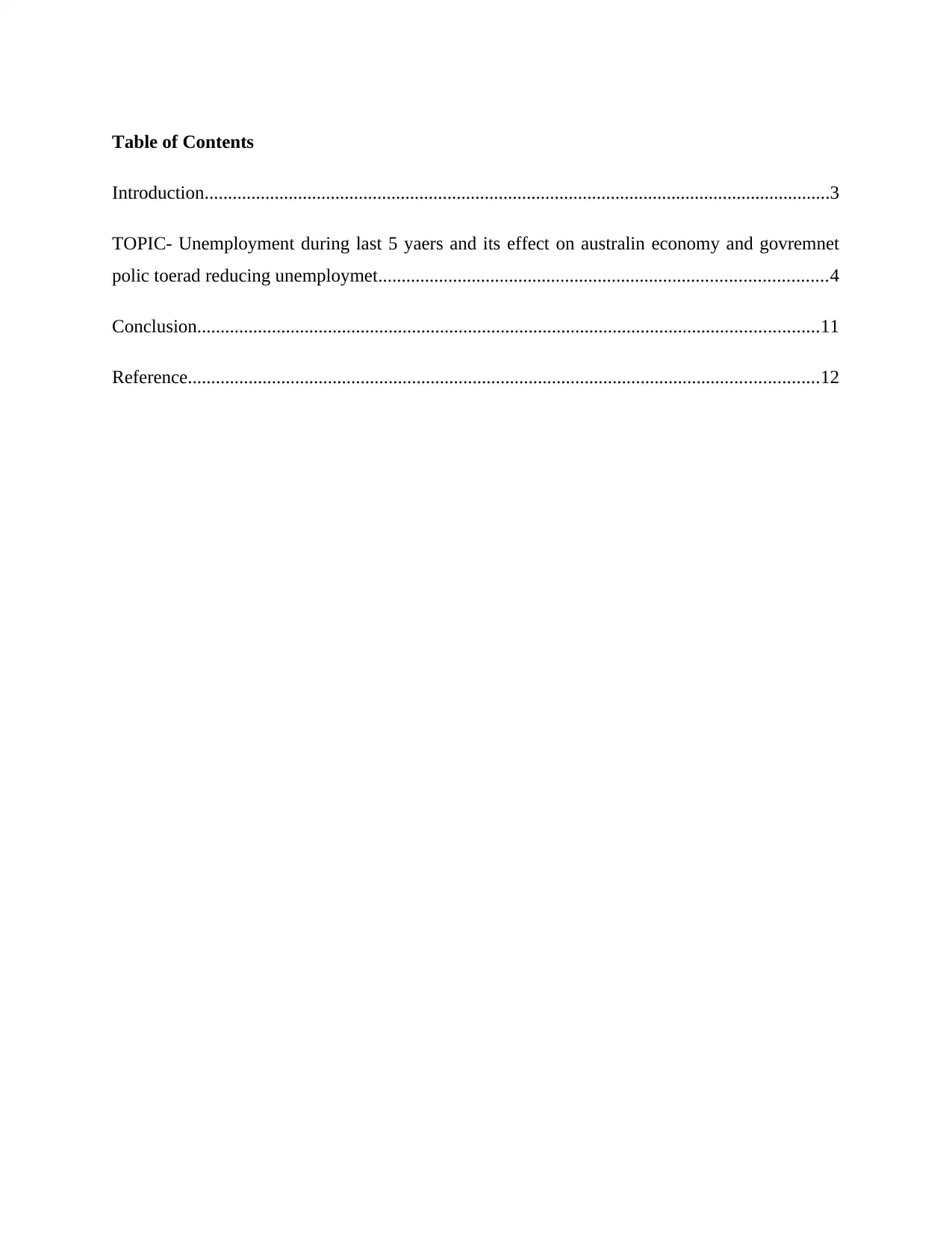
Table of Contents
Introduction......................................................................................................................................3
TOPIC- Unemployment during last 5 yaers and its effect on australin economy and govremnet
polic toerad reducing unemploymet................................................................................................4
Conclusion.....................................................................................................................................11
Reference.......................................................................................................................................12
Introduction......................................................................................................................................3
TOPIC- Unemployment during last 5 yaers and its effect on australin economy and govremnet
polic toerad reducing unemploymet................................................................................................4
Conclusion.....................................................................................................................................11
Reference.......................................................................................................................................12
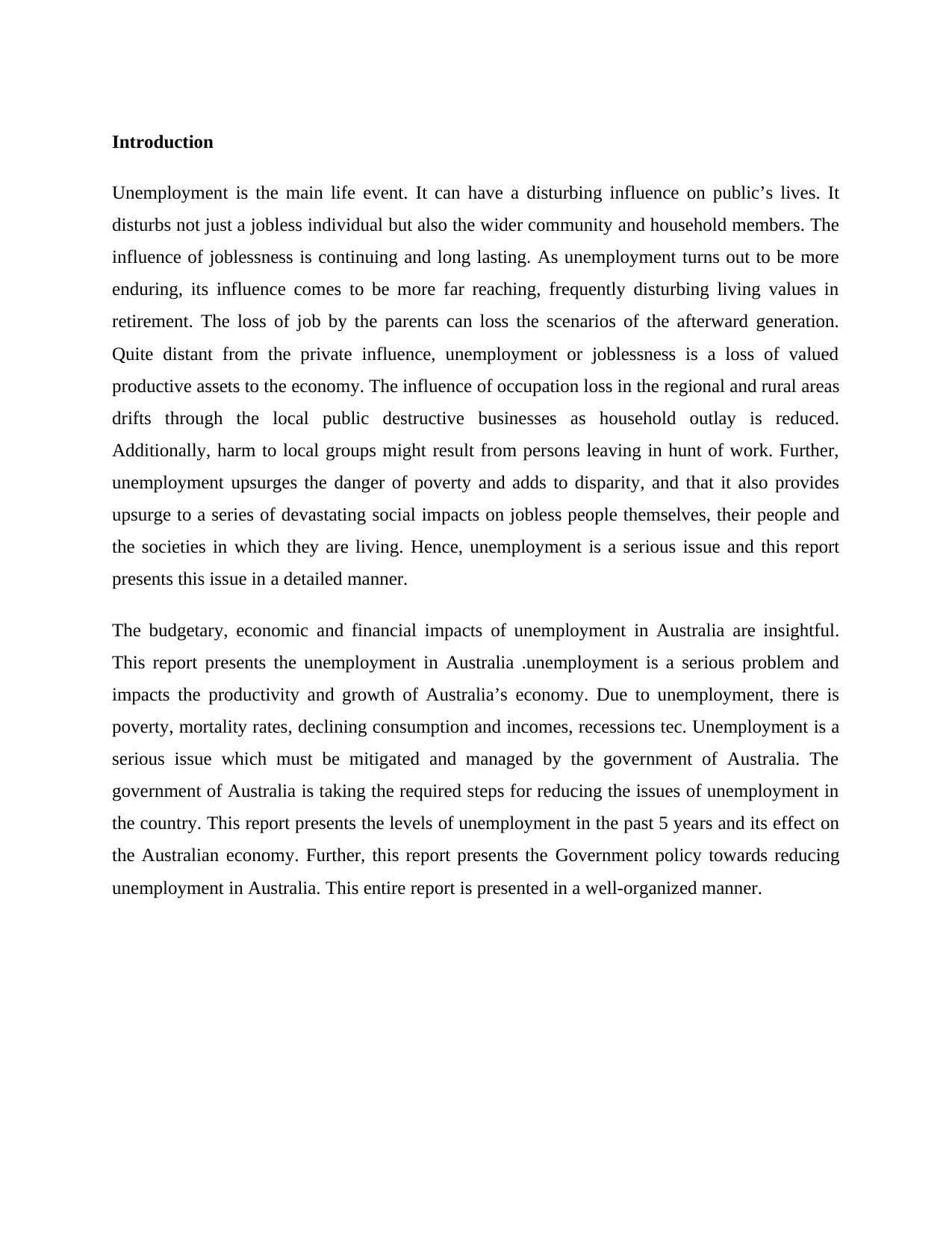
Introduction
Unemployment is the main life event. It can have a disturbing influence on public’s lives. It
disturbs not just a jobless individual but also the wider community and household members. The
influence of joblessness is continuing and long lasting. As unemployment turns out to be more
enduring, its influence comes to be more far reaching, frequently disturbing living values in
retirement. The loss of job by the parents can loss the scenarios of the afterward generation.
Quite distant from the private influence, unemployment or joblessness is a loss of valued
productive assets to the economy. The influence of occupation loss in the regional and rural areas
drifts through the local public destructive businesses as household outlay is reduced.
Additionally, harm to local groups might result from persons leaving in hunt of work. Further,
unemployment upsurges the danger of poverty and adds to disparity, and that it also provides
upsurge to a series of devastating social impacts on jobless people themselves, their people and
the societies in which they are living. Hence, unemployment is a serious issue and this report
presents this issue in a detailed manner.
The budgetary, economic and financial impacts of unemployment in Australia are insightful.
This report presents the unemployment in Australia .unemployment is a serious problem and
impacts the productivity and growth of Australia’s economy. Due to unemployment, there is
poverty, mortality rates, declining consumption and incomes, recessions tec. Unemployment is a
serious issue which must be mitigated and managed by the government of Australia. The
government of Australia is taking the required steps for reducing the issues of unemployment in
the country. This report presents the levels of unemployment in the past 5 years and its effect on
the Australian economy. Further, this report presents the Government policy towards reducing
unemployment in Australia. This entire report is presented in a well-organized manner.
Unemployment is the main life event. It can have a disturbing influence on public’s lives. It
disturbs not just a jobless individual but also the wider community and household members. The
influence of joblessness is continuing and long lasting. As unemployment turns out to be more
enduring, its influence comes to be more far reaching, frequently disturbing living values in
retirement. The loss of job by the parents can loss the scenarios of the afterward generation.
Quite distant from the private influence, unemployment or joblessness is a loss of valued
productive assets to the economy. The influence of occupation loss in the regional and rural areas
drifts through the local public destructive businesses as household outlay is reduced.
Additionally, harm to local groups might result from persons leaving in hunt of work. Further,
unemployment upsurges the danger of poverty and adds to disparity, and that it also provides
upsurge to a series of devastating social impacts on jobless people themselves, their people and
the societies in which they are living. Hence, unemployment is a serious issue and this report
presents this issue in a detailed manner.
The budgetary, economic and financial impacts of unemployment in Australia are insightful.
This report presents the unemployment in Australia .unemployment is a serious problem and
impacts the productivity and growth of Australia’s economy. Due to unemployment, there is
poverty, mortality rates, declining consumption and incomes, recessions tec. Unemployment is a
serious issue which must be mitigated and managed by the government of Australia. The
government of Australia is taking the required steps for reducing the issues of unemployment in
the country. This report presents the levels of unemployment in the past 5 years and its effect on
the Australian economy. Further, this report presents the Government policy towards reducing
unemployment in Australia. This entire report is presented in a well-organized manner.
⊘ This is a preview!⊘
Do you want full access?
Subscribe today to unlock all pages.

Trusted by 1+ million students worldwide
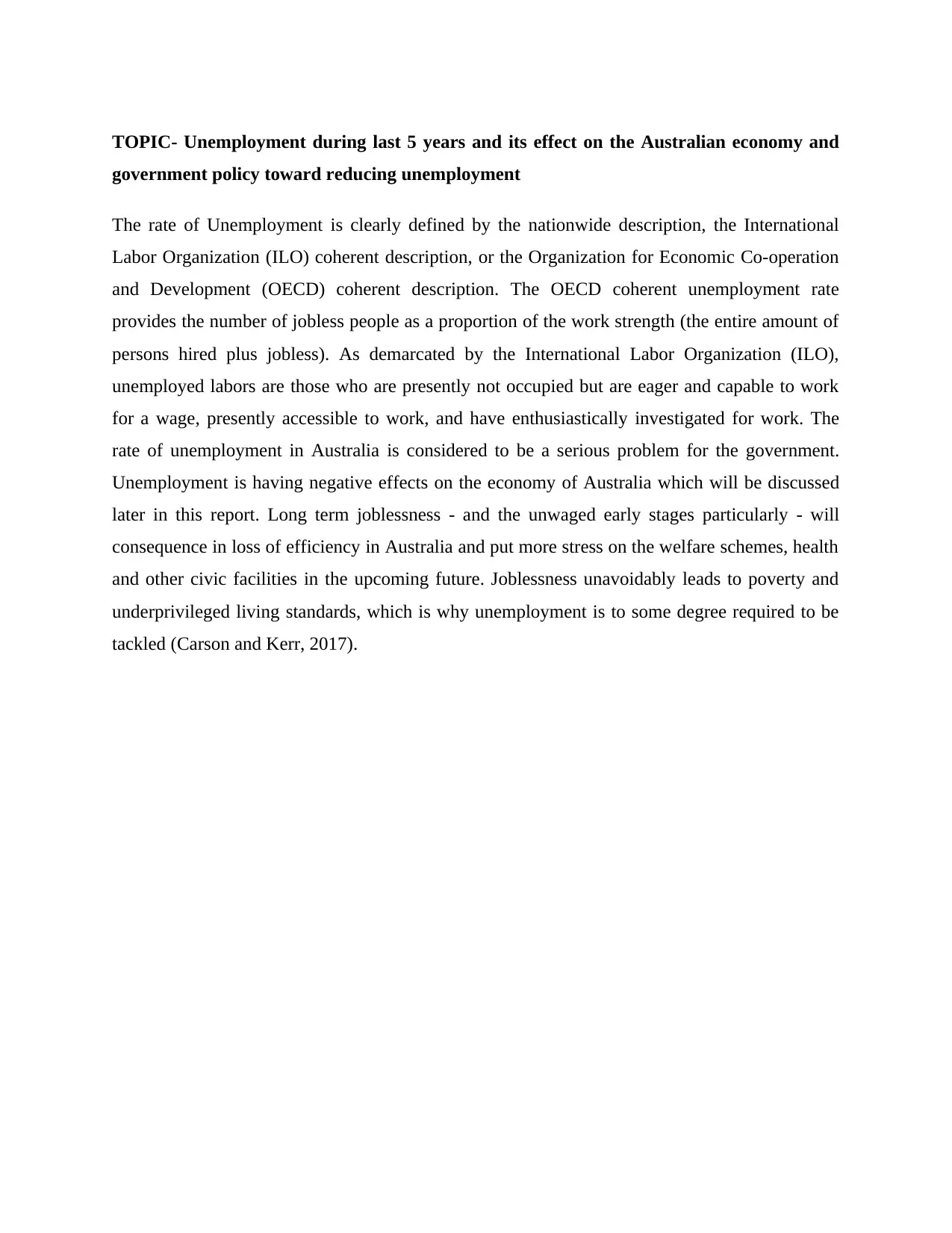
TOPIC- Unemployment during last 5 years and its effect on the Australian economy and
government policy toward reducing unemployment
The rate of Unemployment is clearly defined by the nationwide description, the International
Labor Organization (ILO) coherent description, or the Organization for Economic Co-operation
and Development (OECD) coherent description. The OECD coherent unemployment rate
provides the number of jobless people as a proportion of the work strength (the entire amount of
persons hired plus jobless). As demarcated by the International Labor Organization (ILO),
unemployed labors are those who are presently not occupied but are eager and capable to work
for a wage, presently accessible to work, and have enthusiastically investigated for work. The
rate of unemployment in Australia is considered to be a serious problem for the government.
Unemployment is having negative effects on the economy of Australia which will be discussed
later in this report. Long term joblessness - and the unwaged early stages particularly - will
consequence in loss of efficiency in Australia and put more stress on the welfare schemes, health
and other civic facilities in the upcoming future. Joblessness unavoidably leads to poverty and
underprivileged living standards, which is why unemployment is to some degree required to be
tackled (Carson and Kerr, 2017).
government policy toward reducing unemployment
The rate of Unemployment is clearly defined by the nationwide description, the International
Labor Organization (ILO) coherent description, or the Organization for Economic Co-operation
and Development (OECD) coherent description. The OECD coherent unemployment rate
provides the number of jobless people as a proportion of the work strength (the entire amount of
persons hired plus jobless). As demarcated by the International Labor Organization (ILO),
unemployed labors are those who are presently not occupied but are eager and capable to work
for a wage, presently accessible to work, and have enthusiastically investigated for work. The
rate of unemployment in Australia is considered to be a serious problem for the government.
Unemployment is having negative effects on the economy of Australia which will be discussed
later in this report. Long term joblessness - and the unwaged early stages particularly - will
consequence in loss of efficiency in Australia and put more stress on the welfare schemes, health
and other civic facilities in the upcoming future. Joblessness unavoidably leads to poverty and
underprivileged living standards, which is why unemployment is to some degree required to be
tackled (Carson and Kerr, 2017).
Paraphrase This Document
Need a fresh take? Get an instant paraphrase of this document with our AI Paraphraser
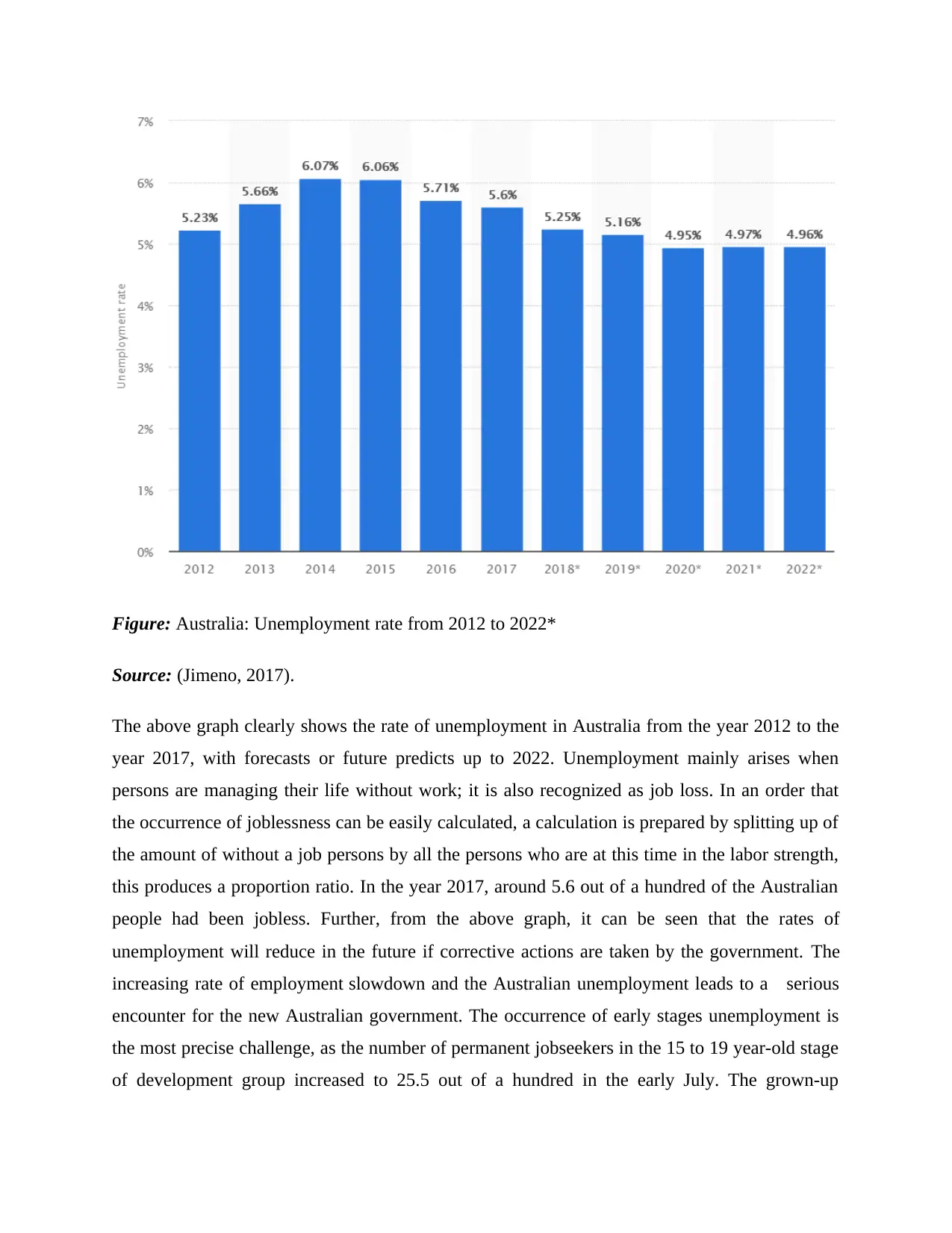
Figure: Australia: Unemployment rate from 2012 to 2022*
Source: (Jimeno, 2017).
The above graph clearly shows the rate of unemployment in Australia from the year 2012 to the
year 2017, with forecasts or future predicts up to 2022. Unemployment mainly arises when
persons are managing their life without work; it is also recognized as job loss. In an order that
the occurrence of joblessness can be easily calculated, a calculation is prepared by splitting up of
the amount of without a job persons by all the persons who are at this time in the labor strength,
this produces a proportion ratio. In the year 2017, around 5.6 out of a hundred of the Australian
people had been jobless. Further, from the above graph, it can be seen that the rates of
unemployment will reduce in the future if corrective actions are taken by the government. The
increasing rate of employment slowdown and the Australian unemployment leads to a serious
encounter for the new Australian government. The occurrence of early stages unemployment is
the most precise challenge, as the number of permanent jobseekers in the 15 to 19 year-old stage
of development group increased to 25.5 out of a hundred in the early July. The grown-up
Source: (Jimeno, 2017).
The above graph clearly shows the rate of unemployment in Australia from the year 2012 to the
year 2017, with forecasts or future predicts up to 2022. Unemployment mainly arises when
persons are managing their life without work; it is also recognized as job loss. In an order that
the occurrence of joblessness can be easily calculated, a calculation is prepared by splitting up of
the amount of without a job persons by all the persons who are at this time in the labor strength,
this produces a proportion ratio. In the year 2017, around 5.6 out of a hundred of the Australian
people had been jobless. Further, from the above graph, it can be seen that the rates of
unemployment will reduce in the future if corrective actions are taken by the government. The
increasing rate of employment slowdown and the Australian unemployment leads to a serious
encounter for the new Australian government. The occurrence of early stages unemployment is
the most precise challenge, as the number of permanent jobseekers in the 15 to 19 year-old stage
of development group increased to 25.5 out of a hundred in the early July. The grown-up
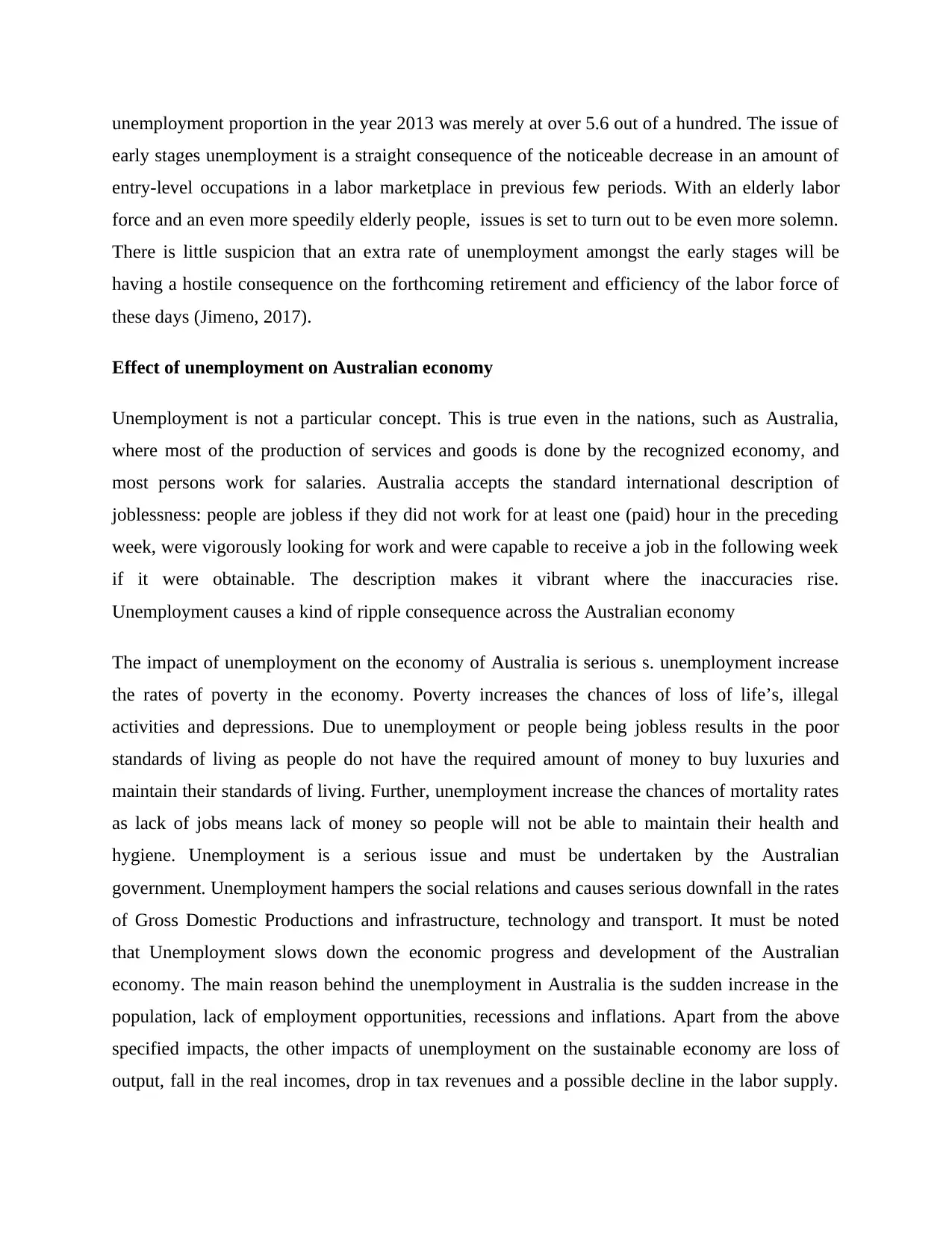
unemployment proportion in the year 2013 was merely at over 5.6 out of a hundred. The issue of
early stages unemployment is a straight consequence of the noticeable decrease in an amount of
entry-level occupations in a labor marketplace in previous few periods. With an elderly labor
force and an even more speedily elderly people, issues is set to turn out to be even more solemn.
There is little suspicion that an extra rate of unemployment amongst the early stages will be
having a hostile consequence on the forthcoming retirement and efficiency of the labor force of
these days (Jimeno, 2017).
Effect of unemployment on Australian economy
Unemployment is not a particular concept. This is true even in the nations, such as Australia,
where most of the production of services and goods is done by the recognized economy, and
most persons work for salaries. Australia accepts the standard international description of
joblessness: people are jobless if they did not work for at least one (paid) hour in the preceding
week, were vigorously looking for work and were capable to receive a job in the following week
if it were obtainable. The description makes it vibrant where the inaccuracies rise.
Unemployment causes a kind of ripple consequence across the Australian economy
The impact of unemployment on the economy of Australia is serious s. unemployment increase
the rates of poverty in the economy. Poverty increases the chances of loss of life’s, illegal
activities and depressions. Due to unemployment or people being jobless results in the poor
standards of living as people do not have the required amount of money to buy luxuries and
maintain their standards of living. Further, unemployment increase the chances of mortality rates
as lack of jobs means lack of money so people will not be able to maintain their health and
hygiene. Unemployment is a serious issue and must be undertaken by the Australian
government. Unemployment hampers the social relations and causes serious downfall in the rates
of Gross Domestic Productions and infrastructure, technology and transport. It must be noted
that Unemployment slows down the economic progress and development of the Australian
economy. The main reason behind the unemployment in Australia is the sudden increase in the
population, lack of employment opportunities, recessions and inflations. Apart from the above
specified impacts, the other impacts of unemployment on the sustainable economy are loss of
output, fall in the real incomes, drop in tax revenues and a possible decline in the labor supply.
early stages unemployment is a straight consequence of the noticeable decrease in an amount of
entry-level occupations in a labor marketplace in previous few periods. With an elderly labor
force and an even more speedily elderly people, issues is set to turn out to be even more solemn.
There is little suspicion that an extra rate of unemployment amongst the early stages will be
having a hostile consequence on the forthcoming retirement and efficiency of the labor force of
these days (Jimeno, 2017).
Effect of unemployment on Australian economy
Unemployment is not a particular concept. This is true even in the nations, such as Australia,
where most of the production of services and goods is done by the recognized economy, and
most persons work for salaries. Australia accepts the standard international description of
joblessness: people are jobless if they did not work for at least one (paid) hour in the preceding
week, were vigorously looking for work and were capable to receive a job in the following week
if it were obtainable. The description makes it vibrant where the inaccuracies rise.
Unemployment causes a kind of ripple consequence across the Australian economy
The impact of unemployment on the economy of Australia is serious s. unemployment increase
the rates of poverty in the economy. Poverty increases the chances of loss of life’s, illegal
activities and depressions. Due to unemployment or people being jobless results in the poor
standards of living as people do not have the required amount of money to buy luxuries and
maintain their standards of living. Further, unemployment increase the chances of mortality rates
as lack of jobs means lack of money so people will not be able to maintain their health and
hygiene. Unemployment is a serious issue and must be undertaken by the Australian
government. Unemployment hampers the social relations and causes serious downfall in the rates
of Gross Domestic Productions and infrastructure, technology and transport. It must be noted
that Unemployment slows down the economic progress and development of the Australian
economy. The main reason behind the unemployment in Australia is the sudden increase in the
population, lack of employment opportunities, recessions and inflations. Apart from the above
specified impacts, the other impacts of unemployment on the sustainable economy are loss of
output, fall in the real incomes, drop in tax revenues and a possible decline in the labor supply.
⊘ This is a preview!⊘
Do you want full access?
Subscribe today to unlock all pages.

Trusted by 1+ million students worldwide
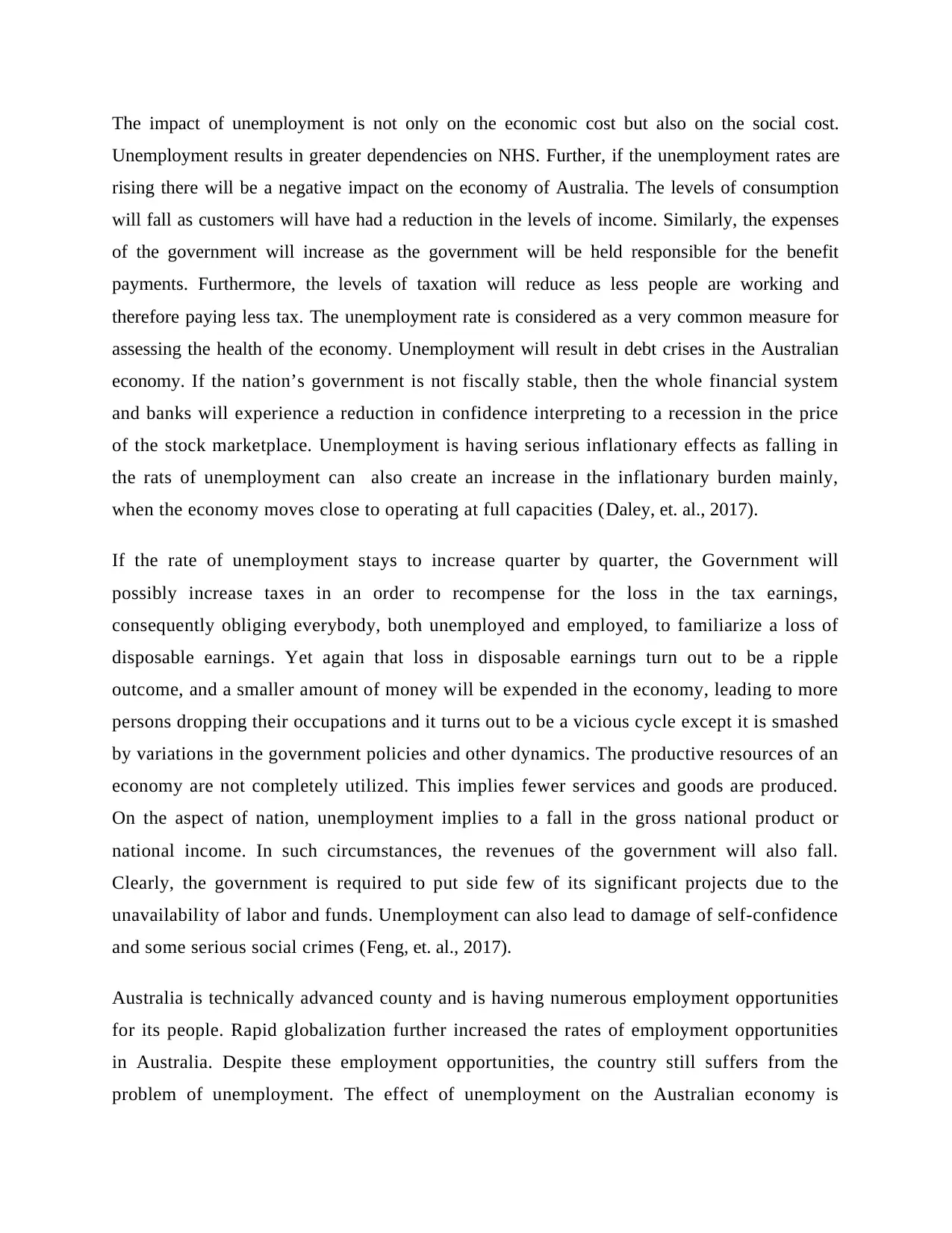
The impact of unemployment is not only on the economic cost but also on the social cost.
Unemployment results in greater dependencies on NHS. Further, if the unemployment rates are
rising there will be a negative impact on the economy of Australia. The levels of consumption
will fall as customers will have had a reduction in the levels of income. Similarly, the expenses
of the government will increase as the government will be held responsible for the benefit
payments. Furthermore, the levels of taxation will reduce as less people are working and
therefore paying less tax. The unemployment rate is considered as a very common measure for
assessing the health of the economy. Unemployment will result in debt crises in the Australian
economy. If the nation’s government is not fiscally stable, then the whole financial system
and banks will experience a reduction in confidence interpreting to a recession in the price
of the stock marketplace. Unemployment is having serious inflationary effects as falling in
the rats of unemployment can also create an increase in the inflationary burden mainly,
when the economy moves close to operating at full capacities (Daley, et. al., 2017).
If the rate of unemployment stays to increase quarter by quarter, the Government will
possibly increase taxes in an order to recompense for the loss in the tax earnings,
consequently obliging everybody, both unemployed and employed, to familiarize a loss of
disposable earnings. Yet again that loss in disposable earnings turn out to be a ripple
outcome, and a smaller amount of money will be expended in the economy, leading to more
persons dropping their occupations and it turns out to be a vicious cycle except it is smashed
by variations in the government policies and other dynamics. The productive resources of an
economy are not completely utilized. This implies fewer services and goods are produced.
On the aspect of nation, unemployment implies to a fall in the gross national product or
national income. In such circumstances, the revenues of the government will also fall.
Clearly, the government is required to put side few of its significant projects due to the
unavailability of labor and funds. Unemployment can also lead to damage of self-confidence
and some serious social crimes (Feng, et. al., 2017).
Australia is technically advanced county and is having numerous employment opportunities
for its people. Rapid globalization further increased the rates of employment opportunities
in Australia. Despite these employment opportunities, the country still suffers from the
problem of unemployment. The effect of unemployment on the Australian economy is
Unemployment results in greater dependencies on NHS. Further, if the unemployment rates are
rising there will be a negative impact on the economy of Australia. The levels of consumption
will fall as customers will have had a reduction in the levels of income. Similarly, the expenses
of the government will increase as the government will be held responsible for the benefit
payments. Furthermore, the levels of taxation will reduce as less people are working and
therefore paying less tax. The unemployment rate is considered as a very common measure for
assessing the health of the economy. Unemployment will result in debt crises in the Australian
economy. If the nation’s government is not fiscally stable, then the whole financial system
and banks will experience a reduction in confidence interpreting to a recession in the price
of the stock marketplace. Unemployment is having serious inflationary effects as falling in
the rats of unemployment can also create an increase in the inflationary burden mainly,
when the economy moves close to operating at full capacities (Daley, et. al., 2017).
If the rate of unemployment stays to increase quarter by quarter, the Government will
possibly increase taxes in an order to recompense for the loss in the tax earnings,
consequently obliging everybody, both unemployed and employed, to familiarize a loss of
disposable earnings. Yet again that loss in disposable earnings turn out to be a ripple
outcome, and a smaller amount of money will be expended in the economy, leading to more
persons dropping their occupations and it turns out to be a vicious cycle except it is smashed
by variations in the government policies and other dynamics. The productive resources of an
economy are not completely utilized. This implies fewer services and goods are produced.
On the aspect of nation, unemployment implies to a fall in the gross national product or
national income. In such circumstances, the revenues of the government will also fall.
Clearly, the government is required to put side few of its significant projects due to the
unavailability of labor and funds. Unemployment can also lead to damage of self-confidence
and some serious social crimes (Feng, et. al., 2017).
Australia is technically advanced county and is having numerous employment opportunities
for its people. Rapid globalization further increased the rates of employment opportunities
in Australia. Despite these employment opportunities, the country still suffers from the
problem of unemployment. The effect of unemployment on the Australian economy is
Paraphrase This Document
Need a fresh take? Get an instant paraphrase of this document with our AI Paraphraser
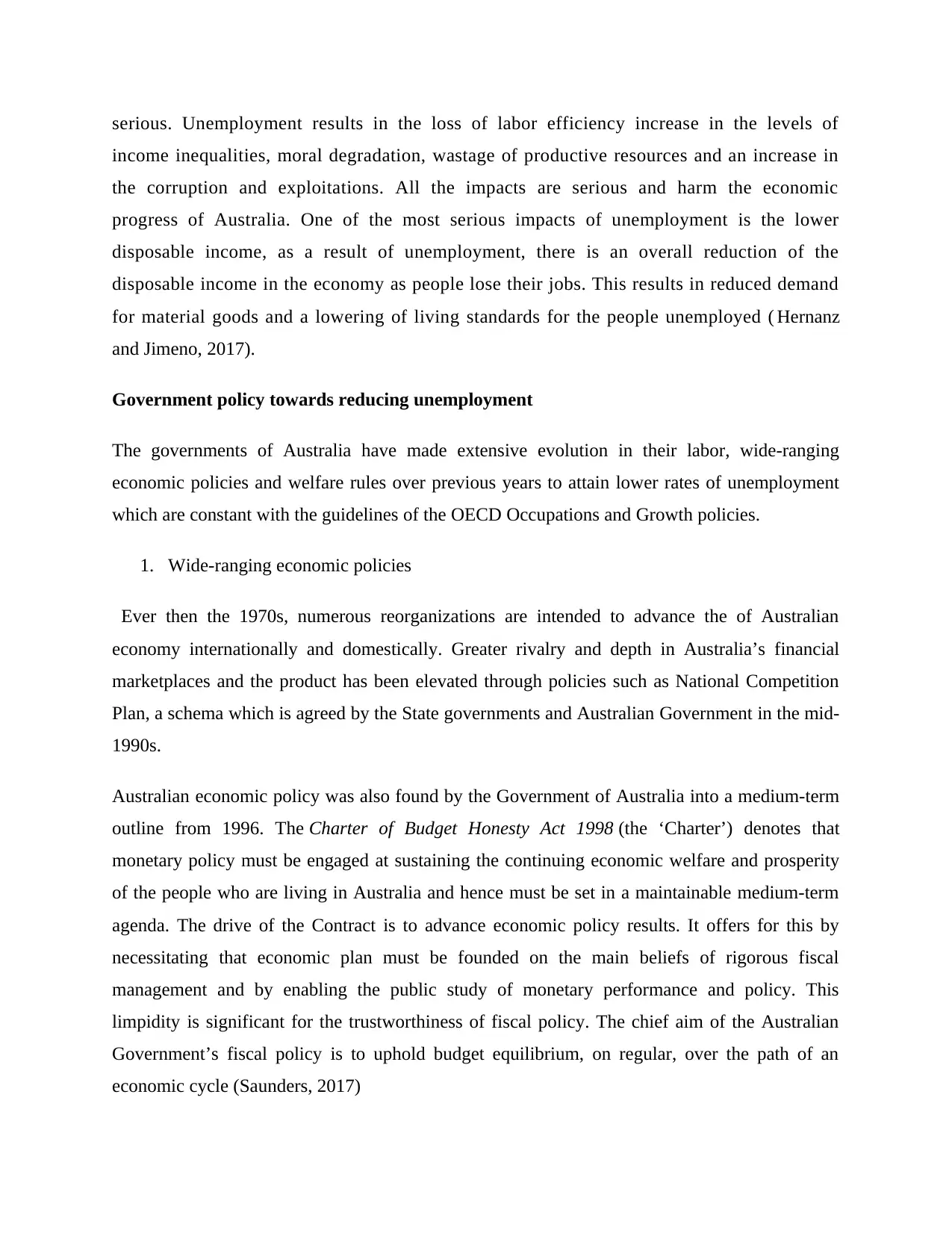
serious. Unemployment results in the loss of labor efficiency increase in the levels of
income inequalities, moral degradation, wastage of productive resources and an increase in
the corruption and exploitations. All the impacts are serious and harm the economic
progress of Australia. One of the most serious impacts of unemployment is the lower
disposable income, as a result of unemployment, there is an overall reduction of the
disposable income in the economy as people lose their jobs. This results in reduced demand
for material goods and a lowering of living standards for the people unemployed ( Hernanz
and Jimeno, 2017).
Government policy towards reducing unemployment
The governments of Australia have made extensive evolution in their labor, wide-ranging
economic policies and welfare rules over previous years to attain lower rates of unemployment
which are constant with the guidelines of the OECD Occupations and Growth policies.
1. Wide-ranging economic policies
Ever then the 1970s, numerous reorganizations are intended to advance the of Australian
economy internationally and domestically. Greater rivalry and depth in Australia’s financial
marketplaces and the product has been elevated through policies such as National Competition
Plan, a schema which is agreed by the State governments and Australian Government in the mid-
1990s.
Australian economic policy was also found by the Government of Australia into a medium-term
outline from 1996. The Charter of Budget Honesty Act 1998 (the ‘Charter’) denotes that
monetary policy must be engaged at sustaining the continuing economic welfare and prosperity
of the people who are living in Australia and hence must be set in a maintainable medium-term
agenda. The drive of the Contract is to advance economic policy results. It offers for this by
necessitating that economic plan must be founded on the main beliefs of rigorous fiscal
management and by enabling the public study of monetary performance and policy. This
limpidity is significant for the trustworthiness of fiscal policy. The chief aim of the Australian
Government’s fiscal policy is to uphold budget equilibrium, on regular, over the path of an
economic cycle (Saunders, 2017)
income inequalities, moral degradation, wastage of productive resources and an increase in
the corruption and exploitations. All the impacts are serious and harm the economic
progress of Australia. One of the most serious impacts of unemployment is the lower
disposable income, as a result of unemployment, there is an overall reduction of the
disposable income in the economy as people lose their jobs. This results in reduced demand
for material goods and a lowering of living standards for the people unemployed ( Hernanz
and Jimeno, 2017).
Government policy towards reducing unemployment
The governments of Australia have made extensive evolution in their labor, wide-ranging
economic policies and welfare rules over previous years to attain lower rates of unemployment
which are constant with the guidelines of the OECD Occupations and Growth policies.
1. Wide-ranging economic policies
Ever then the 1970s, numerous reorganizations are intended to advance the of Australian
economy internationally and domestically. Greater rivalry and depth in Australia’s financial
marketplaces and the product has been elevated through policies such as National Competition
Plan, a schema which is agreed by the State governments and Australian Government in the mid-
1990s.
Australian economic policy was also found by the Government of Australia into a medium-term
outline from 1996. The Charter of Budget Honesty Act 1998 (the ‘Charter’) denotes that
monetary policy must be engaged at sustaining the continuing economic welfare and prosperity
of the people who are living in Australia and hence must be set in a maintainable medium-term
agenda. The drive of the Contract is to advance economic policy results. It offers for this by
necessitating that economic plan must be founded on the main beliefs of rigorous fiscal
management and by enabling the public study of monetary performance and policy. This
limpidity is significant for the trustworthiness of fiscal policy. The chief aim of the Australian
Government’s fiscal policy is to uphold budget equilibrium, on regular, over the path of an
economic cycle (Saunders, 2017)
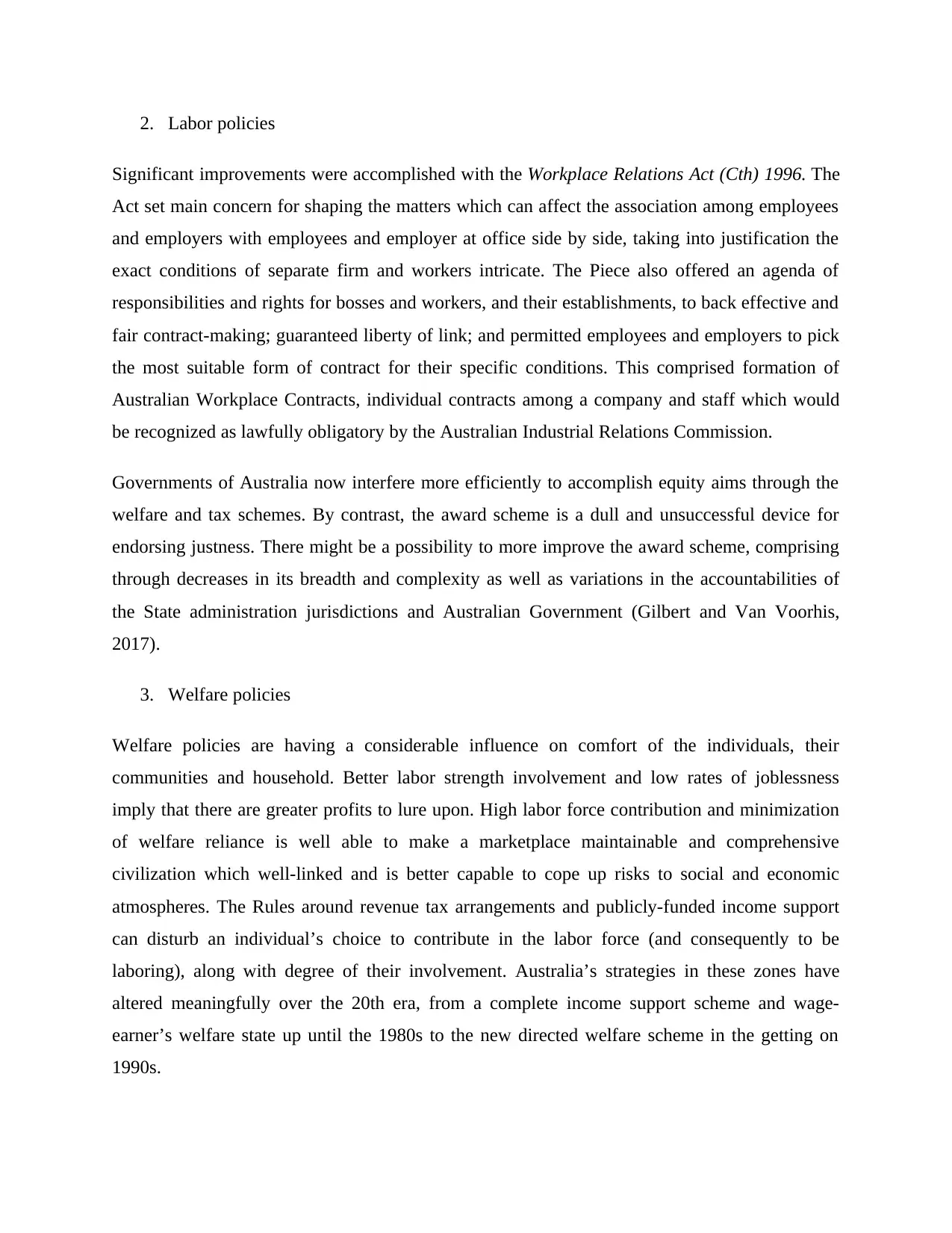
2. Labor policies
Significant improvements were accomplished with the Workplace Relations Act (Cth) 1996. The
Act set main concern for shaping the matters which can affect the association among employees
and employers with employees and employer at office side by side, taking into justification the
exact conditions of separate firm and workers intricate. The Piece also offered an agenda of
responsibilities and rights for bosses and workers, and their establishments, to back effective and
fair contract-making; guaranteed liberty of link; and permitted employees and employers to pick
the most suitable form of contract for their specific conditions. This comprised formation of
Australian Workplace Contracts, individual contracts among a company and staff which would
be recognized as lawfully obligatory by the Australian Industrial Relations Commission.
Governments of Australia now interfere more efficiently to accomplish equity aims through the
welfare and tax schemes. By contrast, the award scheme is a dull and unsuccessful device for
endorsing justness. There might be a possibility to more improve the award scheme, comprising
through decreases in its breadth and complexity as well as variations in the accountabilities of
the State administration jurisdictions and Australian Government (Gilbert and Van Voorhis,
2017).
3. Welfare policies
Welfare policies are having a considerable influence on comfort of the individuals, their
communities and household. Better labor strength involvement and low rates of joblessness
imply that there are greater profits to lure upon. High labor force contribution and minimization
of welfare reliance is well able to make a marketplace maintainable and comprehensive
civilization which well-linked and is better capable to cope up risks to social and economic
atmospheres. The Rules around revenue tax arrangements and publicly-funded income support
can disturb an individual’s choice to contribute in the labor force (and consequently to be
laboring), along with degree of their involvement. Australia’s strategies in these zones have
altered meaningfully over the 20th era, from a complete income support scheme and wage-
earner’s welfare state up until the 1980s to the new directed welfare scheme in the getting on
1990s.
Significant improvements were accomplished with the Workplace Relations Act (Cth) 1996. The
Act set main concern for shaping the matters which can affect the association among employees
and employers with employees and employer at office side by side, taking into justification the
exact conditions of separate firm and workers intricate. The Piece also offered an agenda of
responsibilities and rights for bosses and workers, and their establishments, to back effective and
fair contract-making; guaranteed liberty of link; and permitted employees and employers to pick
the most suitable form of contract for their specific conditions. This comprised formation of
Australian Workplace Contracts, individual contracts among a company and staff which would
be recognized as lawfully obligatory by the Australian Industrial Relations Commission.
Governments of Australia now interfere more efficiently to accomplish equity aims through the
welfare and tax schemes. By contrast, the award scheme is a dull and unsuccessful device for
endorsing justness. There might be a possibility to more improve the award scheme, comprising
through decreases in its breadth and complexity as well as variations in the accountabilities of
the State administration jurisdictions and Australian Government (Gilbert and Van Voorhis,
2017).
3. Welfare policies
Welfare policies are having a considerable influence on comfort of the individuals, their
communities and household. Better labor strength involvement and low rates of joblessness
imply that there are greater profits to lure upon. High labor force contribution and minimization
of welfare reliance is well able to make a marketplace maintainable and comprehensive
civilization which well-linked and is better capable to cope up risks to social and economic
atmospheres. The Rules around revenue tax arrangements and publicly-funded income support
can disturb an individual’s choice to contribute in the labor force (and consequently to be
laboring), along with degree of their involvement. Australia’s strategies in these zones have
altered meaningfully over the 20th era, from a complete income support scheme and wage-
earner’s welfare state up until the 1980s to the new directed welfare scheme in the getting on
1990s.
⊘ This is a preview!⊘
Do you want full access?
Subscribe today to unlock all pages.

Trusted by 1+ million students worldwide
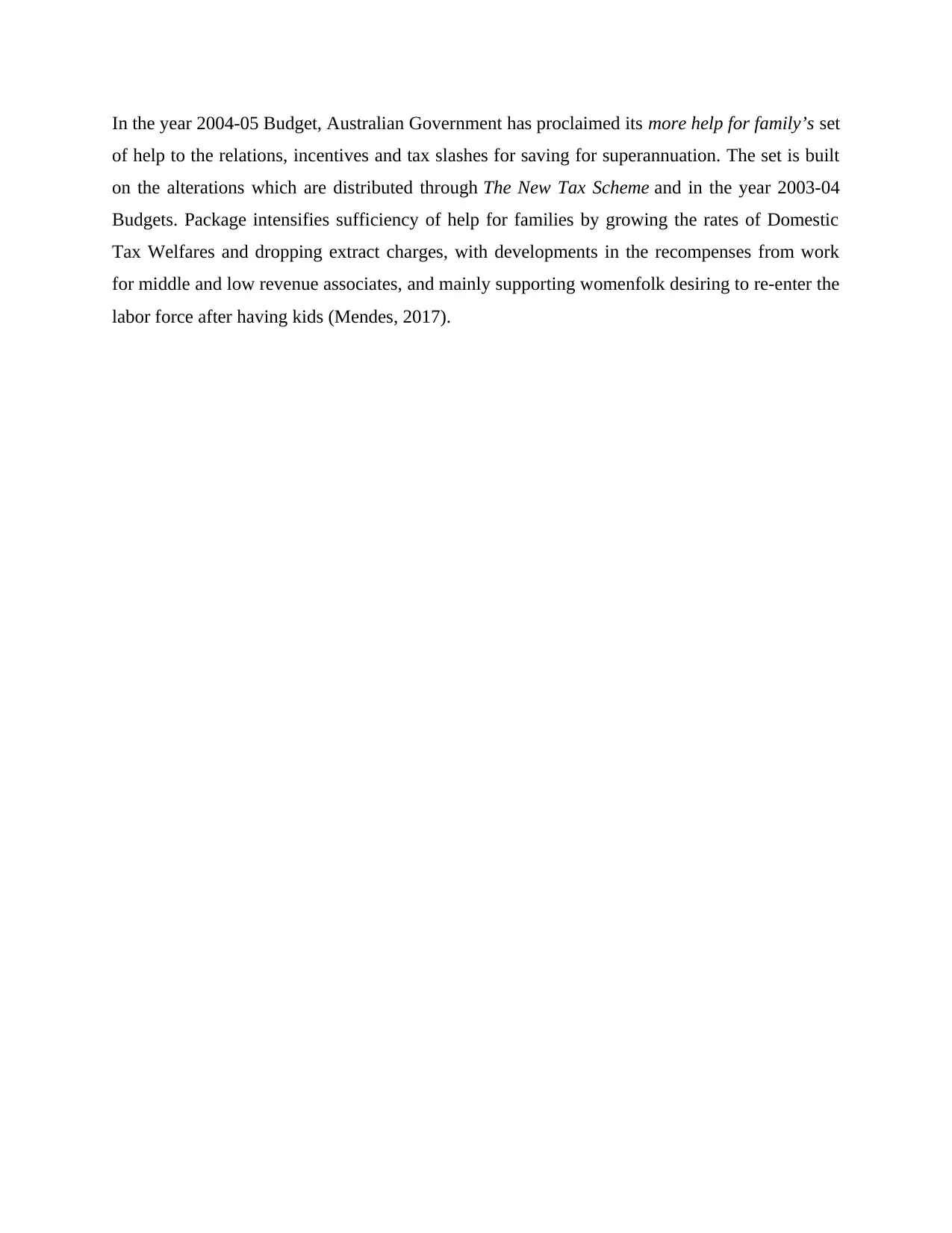
In the year 2004-05 Budget, Australian Government has proclaimed its more help for family’s set
of help to the relations, incentives and tax slashes for saving for superannuation. The set is built
on the alterations which are distributed through The New Tax Scheme and in the year 2003-04
Budgets. Package intensifies sufficiency of help for families by growing the rates of Domestic
Tax Welfares and dropping extract charges, with developments in the recompenses from work
for middle and low revenue associates, and mainly supporting womenfolk desiring to re-enter the
labor force after having kids (Mendes, 2017).
of help to the relations, incentives and tax slashes for saving for superannuation. The set is built
on the alterations which are distributed through The New Tax Scheme and in the year 2003-04
Budgets. Package intensifies sufficiency of help for families by growing the rates of Domestic
Tax Welfares and dropping extract charges, with developments in the recompenses from work
for middle and low revenue associates, and mainly supporting womenfolk desiring to re-enter the
labor force after having kids (Mendes, 2017).
Paraphrase This Document
Need a fresh take? Get an instant paraphrase of this document with our AI Paraphraser
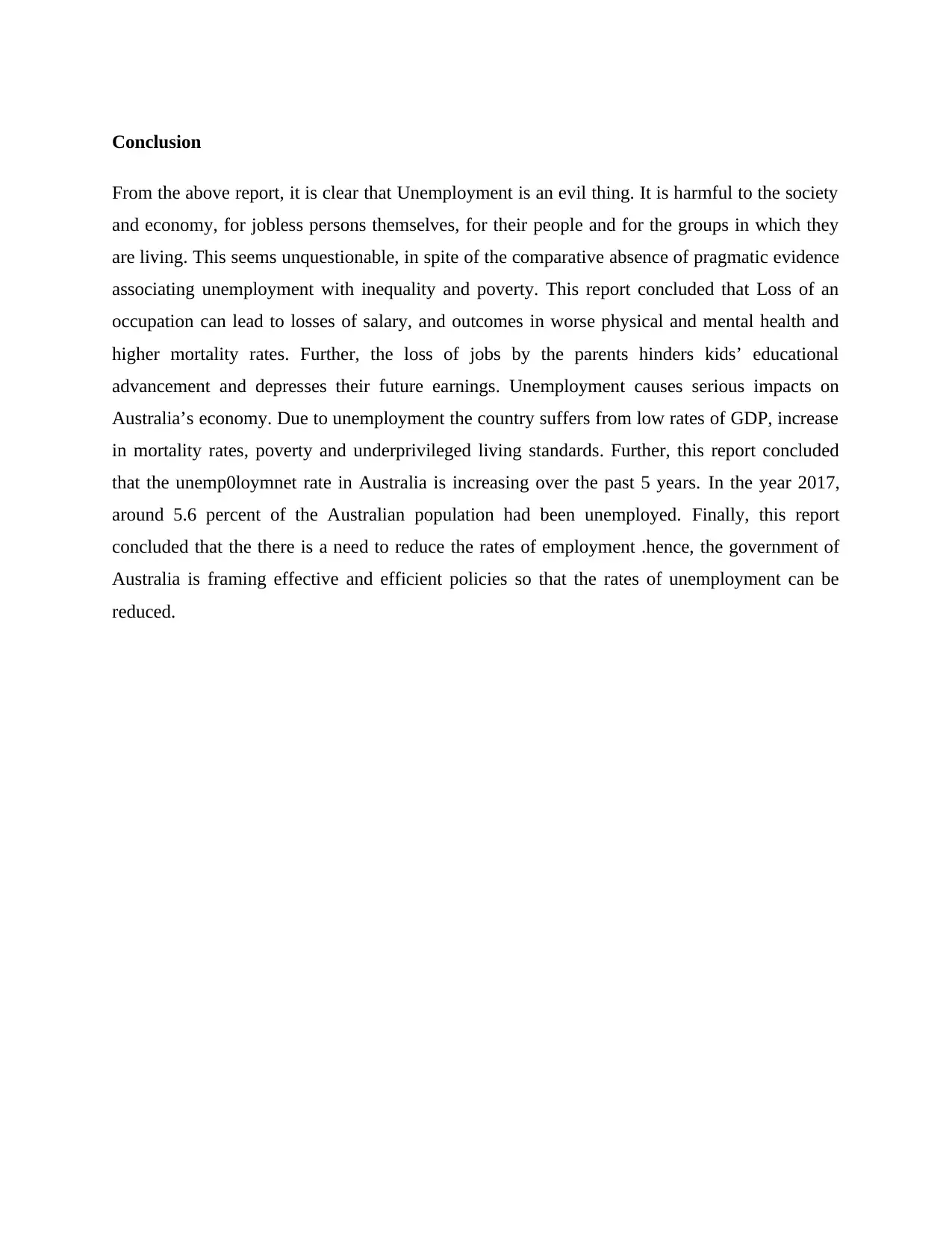
Conclusion
From the above report, it is clear that Unemployment is an evil thing. It is harmful to the society
and economy, for jobless persons themselves, for their people and for the groups in which they
are living. This seems unquestionable, in spite of the comparative absence of pragmatic evidence
associating unemployment with inequality and poverty. This report concluded that Loss of an
occupation can lead to losses of salary, and outcomes in worse physical and mental health and
higher mortality rates. Further, the loss of jobs by the parents hinders kids’ educational
advancement and depresses their future earnings. Unemployment causes serious impacts on
Australia’s economy. Due to unemployment the country suffers from low rates of GDP, increase
in mortality rates, poverty and underprivileged living standards. Further, this report concluded
that the unemp0loymnet rate in Australia is increasing over the past 5 years. In the year 2017,
around 5.6 percent of the Australian population had been unemployed. Finally, this report
concluded that the there is a need to reduce the rates of employment .hence, the government of
Australia is framing effective and efficient policies so that the rates of unemployment can be
reduced.
From the above report, it is clear that Unemployment is an evil thing. It is harmful to the society
and economy, for jobless persons themselves, for their people and for the groups in which they
are living. This seems unquestionable, in spite of the comparative absence of pragmatic evidence
associating unemployment with inequality and poverty. This report concluded that Loss of an
occupation can lead to losses of salary, and outcomes in worse physical and mental health and
higher mortality rates. Further, the loss of jobs by the parents hinders kids’ educational
advancement and depresses their future earnings. Unemployment causes serious impacts on
Australia’s economy. Due to unemployment the country suffers from low rates of GDP, increase
in mortality rates, poverty and underprivileged living standards. Further, this report concluded
that the unemp0loymnet rate in Australia is increasing over the past 5 years. In the year 2017,
around 5.6 percent of the Australian population had been unemployed. Finally, this report
concluded that the there is a need to reduce the rates of employment .hence, the government of
Australia is framing effective and efficient policies so that the rates of unemployment can be
reduced.
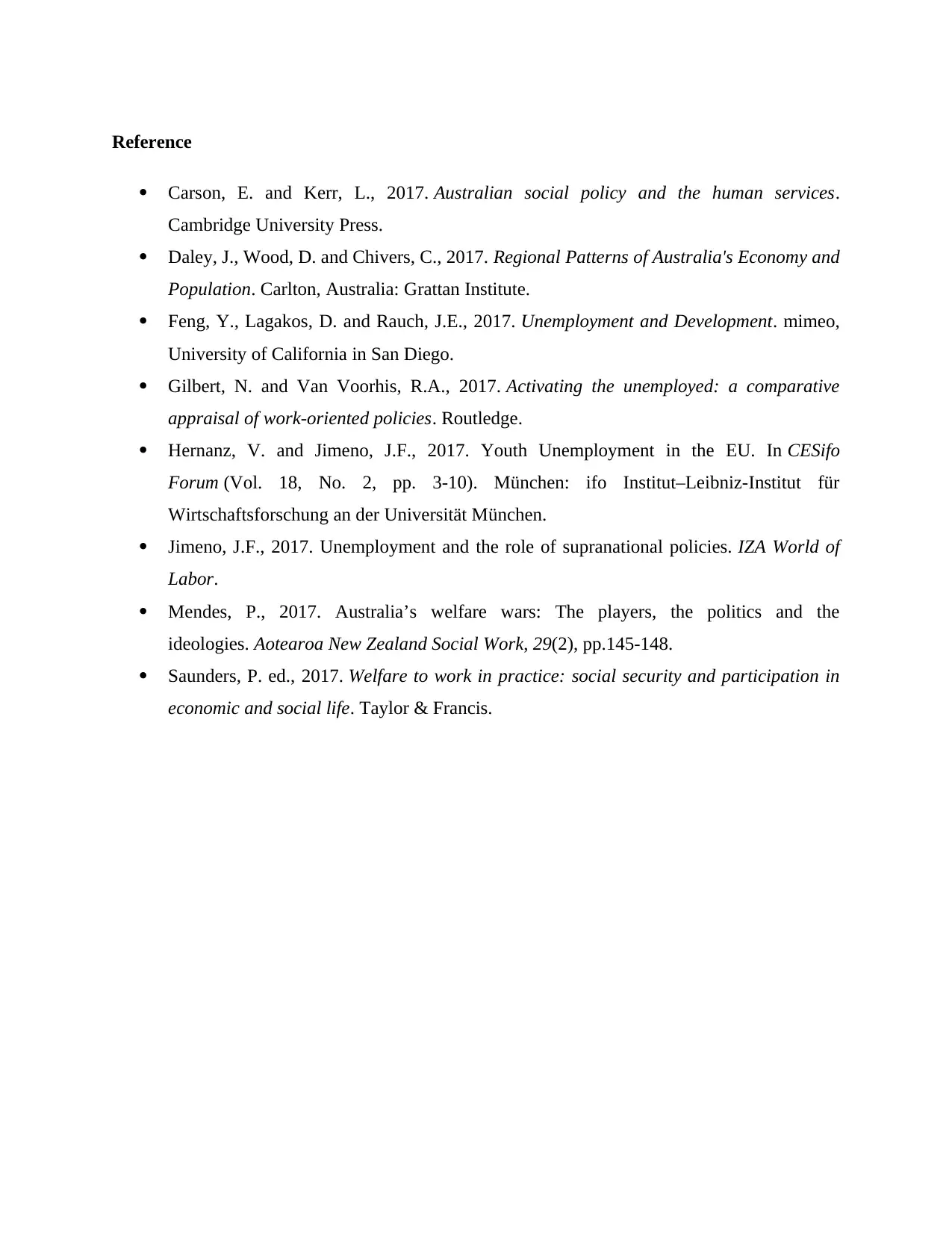
Reference
Carson, E. and Kerr, L., 2017. Australian social policy and the human services.
Cambridge University Press.
Daley, J., Wood, D. and Chivers, C., 2017. Regional Patterns of Australia's Economy and
Population. Carlton, Australia: Grattan Institute.
Feng, Y., Lagakos, D. and Rauch, J.E., 2017. Unemployment and Development. mimeo,
University of California in San Diego.
Gilbert, N. and Van Voorhis, R.A., 2017. Activating the unemployed: a comparative
appraisal of work-oriented policies. Routledge.
Hernanz, V. and Jimeno, J.F., 2017. Youth Unemployment in the EU. In CESifo
Forum (Vol. 18, No. 2, pp. 3-10). München: ifo Institut–Leibniz-Institut für
Wirtschaftsforschung an der Universität München.
Jimeno, J.F., 2017. Unemployment and the role of supranational policies. IZA World of
Labor.
Mendes, P., 2017. Australia’s welfare wars: The players, the politics and the
ideologies. Aotearoa New Zealand Social Work, 29(2), pp.145-148.
Saunders, P. ed., 2017. Welfare to work in practice: social security and participation in
economic and social life. Taylor & Francis.
Carson, E. and Kerr, L., 2017. Australian social policy and the human services.
Cambridge University Press.
Daley, J., Wood, D. and Chivers, C., 2017. Regional Patterns of Australia's Economy and
Population. Carlton, Australia: Grattan Institute.
Feng, Y., Lagakos, D. and Rauch, J.E., 2017. Unemployment and Development. mimeo,
University of California in San Diego.
Gilbert, N. and Van Voorhis, R.A., 2017. Activating the unemployed: a comparative
appraisal of work-oriented policies. Routledge.
Hernanz, V. and Jimeno, J.F., 2017. Youth Unemployment in the EU. In CESifo
Forum (Vol. 18, No. 2, pp. 3-10). München: ifo Institut–Leibniz-Institut für
Wirtschaftsforschung an der Universität München.
Jimeno, J.F., 2017. Unemployment and the role of supranational policies. IZA World of
Labor.
Mendes, P., 2017. Australia’s welfare wars: The players, the politics and the
ideologies. Aotearoa New Zealand Social Work, 29(2), pp.145-148.
Saunders, P. ed., 2017. Welfare to work in practice: social security and participation in
economic and social life. Taylor & Francis.
⊘ This is a preview!⊘
Do you want full access?
Subscribe today to unlock all pages.

Trusted by 1+ million students worldwide
1 out of 12
Related Documents
Your All-in-One AI-Powered Toolkit for Academic Success.
+13062052269
info@desklib.com
Available 24*7 on WhatsApp / Email
![[object Object]](/_next/static/media/star-bottom.7253800d.svg)
Unlock your academic potential
Copyright © 2020–2025 A2Z Services. All Rights Reserved. Developed and managed by ZUCOL.





